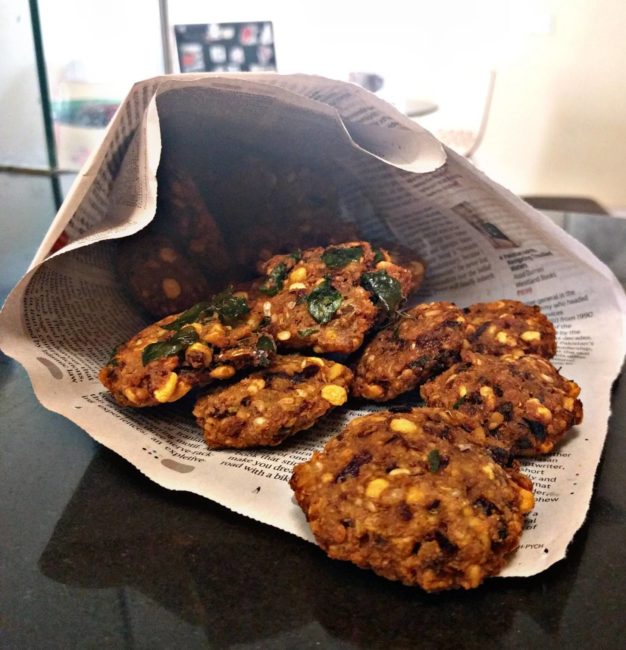Vazhapoo Vadai (Banana flowers fritters)
“I’m going to be half an hour early, do you think it would be rude if I ordered a cup of tea?” I asked in a panic, as the cab I was in navigated the evening school rush towards the Savera hotel where I was meeting Chef Thomas Zacharias. And even though the person on the other end of the line assured me that it wouldn’t be the end of the world if I did indeed order tea while I waited, I was almost sure that once I got there, I’d just find a table facing the door and keep staring, twisting my fingers into a pretzel.
“Seriously, calm yourself!” I ordered myself as I walked towards the Brew Room. “You can use the time to organise…” I trailed off and my brain came to a halt as I saw him standing there, shaking someone’s hand.
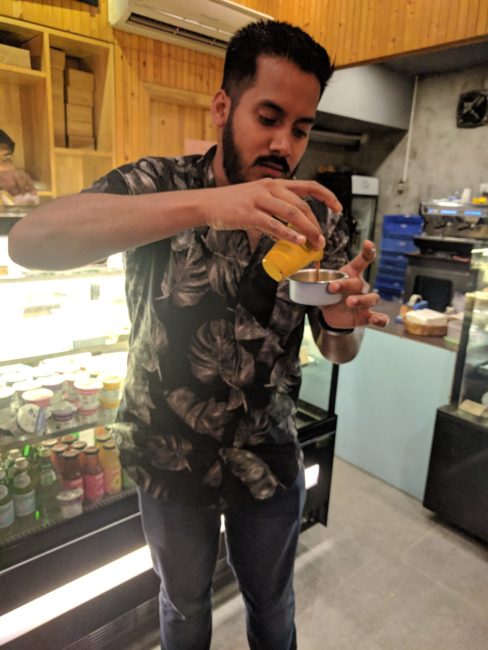
The young Chef Thomas of the famous The Bombay Canteen in Bombay was on the last leg of his expedition across Tamil Nadu, a part of his ‘Chef on the Road’ project. Madras was his last stop, preceded by cities and towns such as Coimbatore, Dindigul, Karaikudi, and many others. He was on a mission to learn and share with the world the various cuisines that Tamilians had to offer, shattering the idea that the best we have to offer are our idlis, dosas, and chettinad chicken, although those are pretty damn good too.
As he led me to his table and we ordered the tea that I had fretted about, I felt my nervousness shake off, bit by bit as I listened to him speak about his journey so far. We spoke about the many aspects of being a chef, the primary being the simple joy of putting a smile on someone’s face by placing a plate of food in front of them. Another fascinating part is discovering the nuances of various cuisines. India has so much to offer that even if we spent a lifetime learning all the cuisines that are out there, we’d not be close to scratching the surface. The man who looked understandably tired at the beginning of our meeting was completely alive when he started talking about the splendid, like-minded people who work with him and share a similar passion about food and bringing about the Indian food movement. A movement that is not about hipster things like drops of avocado oil on your plate to lick clean, but about fusing traditional recipes with modern concepts and laying to rest the naysayers who believe that Indian food cannot be pretty.
Towards the end, I asked him about the places he intends to visit in Madras, eager to add in a few suggestions of my own, such as Seena Bai Tiffin Center or Karpagam Mess. He stopped me short and told me that he was being escorted by a true Madras foodie, Chef Sandesh Reddy, known very well to everyone in town as Sandy of Sandy’s Chocolate Laboratory. And that I was welcome to join them for the evening! It took all my willpower to not embarrass myself by doing the happy dance right then and there.
When I had first heard of Sandy, I was in high school and he had just opened a small exquisite bakery at the end of the road where my friend used to stay, one we visited regularly. From there, he went on to open twenty three successful restaurants, eateries, bakeries, and bars in Tamil Nadu and Andhra Pradesh. He was the down-to-earth mogul that I was dying to meet. Already riding the high of meeting Chef Thomas and the chance to eat the kind of food that I’d been drooling over following the chef’s Instagram page, I was on cloud nine with the turn of the evening.
As we waited for Sandy, we were joined by the Chef’s brother and sister-in-law who were accompanying him on his expedition, along with a fellow foodie who had offered to follow him, recording the whole process. Before long, it was time to leave for our first destination, Maris Hotel, one of Madras’ oldest vegetarian restaurants, famous for its dosas, red chutney, banana flower fritters, and old Mylapore (a largely Iyer Brahmin populated area) men drinking in the bar.
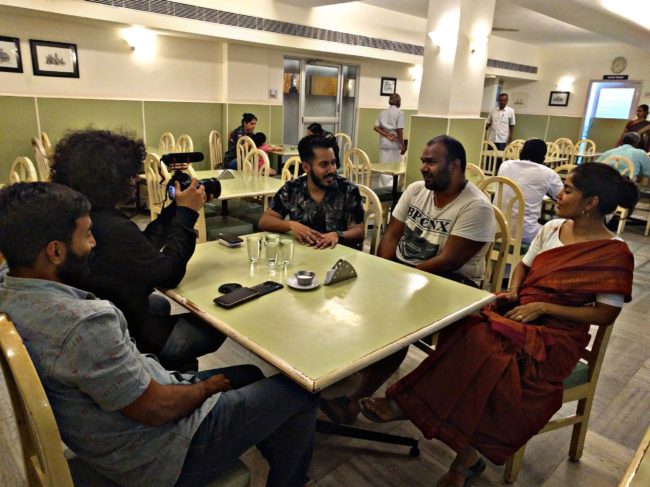
We were joined by Sandy in the middle of our confusion between ordering ghee roast, which is usually paper thin crispy dosa, and ghee dosa, which is a mildly thicker version. Once we got the dosa and the accompanying chutneys, he explained to us about how the difference in taste was owed to the reversal of proportions of the rice and lentils. The highlight, in my opinion, were the banana flower fritters, little flat discs made out of a batter of channa dal and chopped banana blossoms, locally known as Vazhapoo Vadai.

At the end, when we asked for the bill, we were politely asked to finish the remaining dosa and were offered more cups of sambar (which was amazing, not too sweet, not too watery, just the way Goldilocks would’ve liked it!) and chutney to finish it.
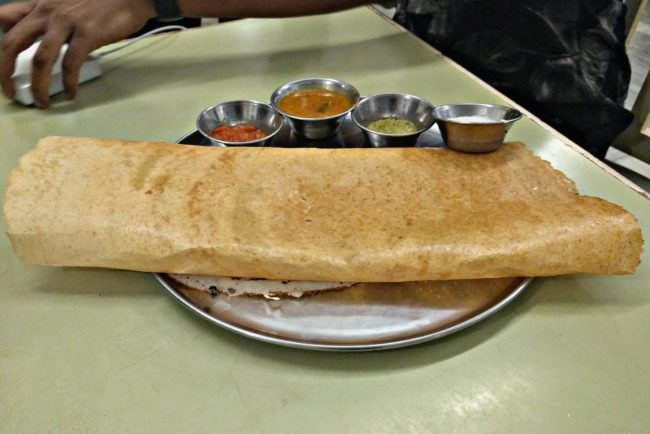
We moved on to the next location on the list of Sandy’s addas (favourite hangouts), which was a small restaurant called Madurai Pandian Restaurant, with freshly tiled walls to attract affluent customers as well. We ordered for a Kari dosa, Madurai’s favorite, which is a small dosa, nice and thick, topped with egg and mutton kheema, slow roasted until it becomes almost black, or kari.
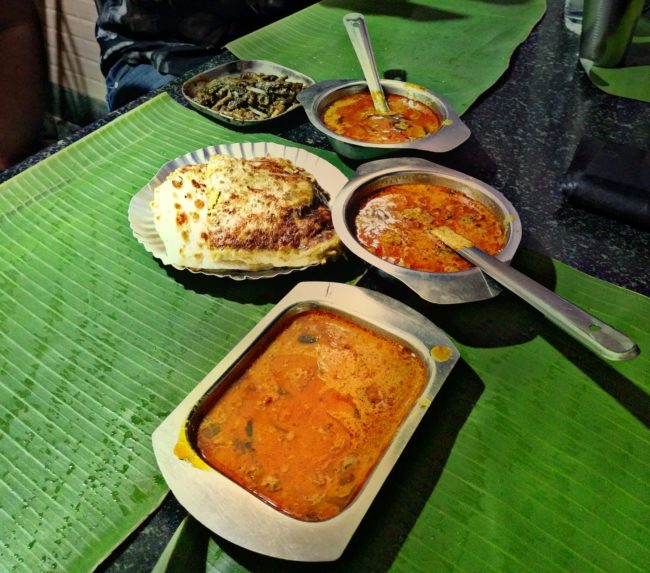
With a side of mutton gravy and naatu kozhi (country style chicken) gravy to dip it in, the slow roasted dosa, especially the crispy edges, was easily my favourite. We also ordered spicy boti (offal), something I haven’t tried in years. The gamey meat had absorbed all the masala, juicy with each bite. I also had, for the first time, mutton lappa which is essentially parotta layered evenly with mutton gravy and covered with egg, roasted until it is nice and crisp on top. I’m very curious to try making this at home to see how I can get the top layer to be so wonderfully crunchy.
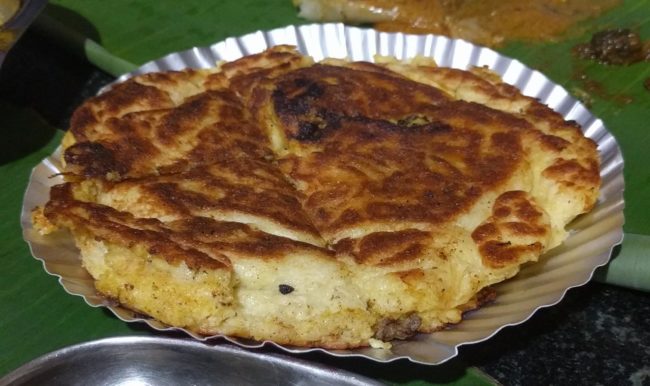
Right before we called for the bill, Sandy asked us if we’d ever tried Karandi muttai, the literal translation being ‘ladle egg’. It is exactly what it is named, an egg cooked to perfection on a ladle, somewhere with a consistency in between a scrambled egg and an omelette, seasoned with nothing other than simple salt and pepper. Eating that made me realise how often we underestimate a perfectly cooked egg, many times willing to discount rubbery eggs.
It was the same kind of simplicity and perfection we were met with when we ordered Kalaki in the next restaurant we visited, Viswanathan Chettinadu Hotel. Kalaki in Tamil means to stir things up or cause trouble, this egg was stirred up to be sublime, once again seasoned simply with salt and pepper! We ordered a mutton biryani, the meat of which was cooked in the biryani and was not richly marinated, but was simple, falling away from the bone, perfect with the spiced biryani.
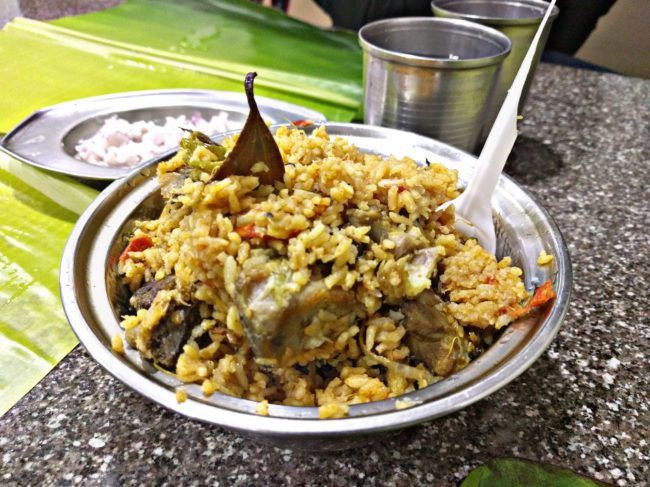
By the time we were halfway through the meal and I was making notes about the crab gravy and the prawn thokku, I started thinking about the flavours that we had tasted in the previous restaurant, which my tongue had already forgotten.
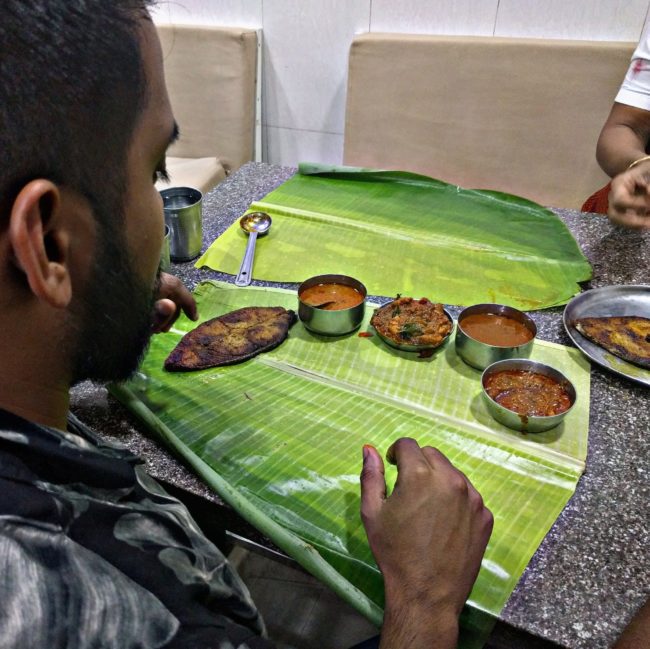
I watched chef Thomas carefully taste each dish and remembered asking him earlier in the day, how he managed to remember everything he’d tasted during the journey. “A palate that remembers”, he had said. But, here’s the thing, I think it is not that simple a gift, but also years and years of training your palate to not just recognise ingredients, but remember them as well. And until I get to that point, my best friend is going to be my notebook which shall record every smell, taste, and sense I experience.
For dessert, we paid a visit to the Old Madras Baking Company (one of Sandy’s bakeries). As we opened the door to the bakery, we got hit with a strong aroma of freshly baked bread that made me weak in the knees (such a sucker for bakeries.) Sandy went behind the counter to whip up some fresh coffee and also to pull out his favourite desserts and pastries. Despite being ridiculously stuffed, I couldn’t help myself from getting a bite of that Victorian cake, again and again.
As much as I had been craving local Tamil food for the last three years, stuffing my face with it was not what clinched my evening, but rather it was these two humble men, who have achieved great things, having a genuine conversation about food, bouncing ideas off each other, without any inhibitions or fear of theft. I feel like this is how pioneers in any industry work, they learn from each other, feed off their energy, and go on to create great things that challenge the common man’s perception.
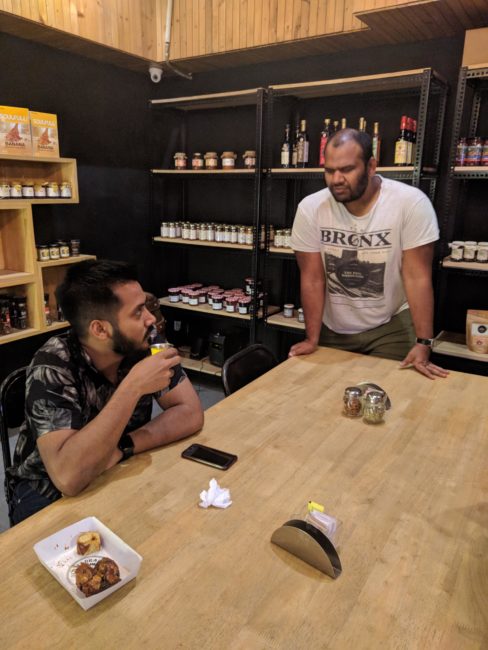
On the way home, I was already going over in my head about how to shape this article, what to emphasise and so on, but the minute I recounted the whole experience to my mom, the first thing she said was “We should try making Vazhapoo Vadai!” Watching my mom’s excited face, I got sidetracked and after a quick visit to the local vegetable market, we were all ready to get started (I love how I no longer have to worry about sourcing ingredients from New York!) Because neither of us have ever tried making this vadai before, we were working off the memory of my mom watching her dad make them and that just made it more exciting.
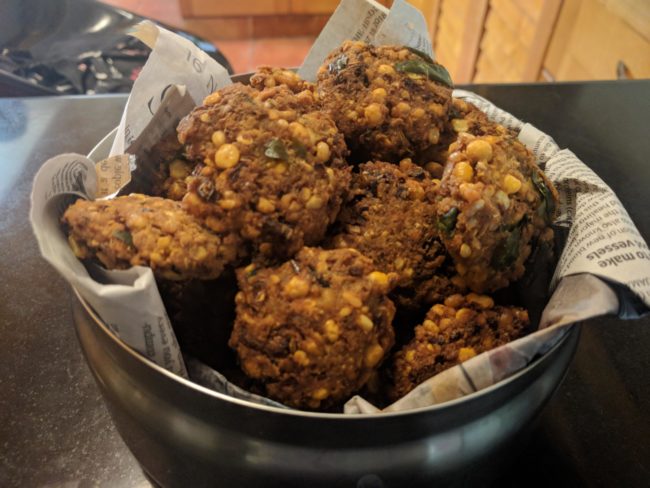
We left the lentils to soak for four hours and in the meantime, started with the banana flowers. For those who haven’t dealt with these flowers, the idea is to peel off the red covering layer, pluck the pretty pale yellow flowers inside, find the stigma in between, pull it out and discard it.
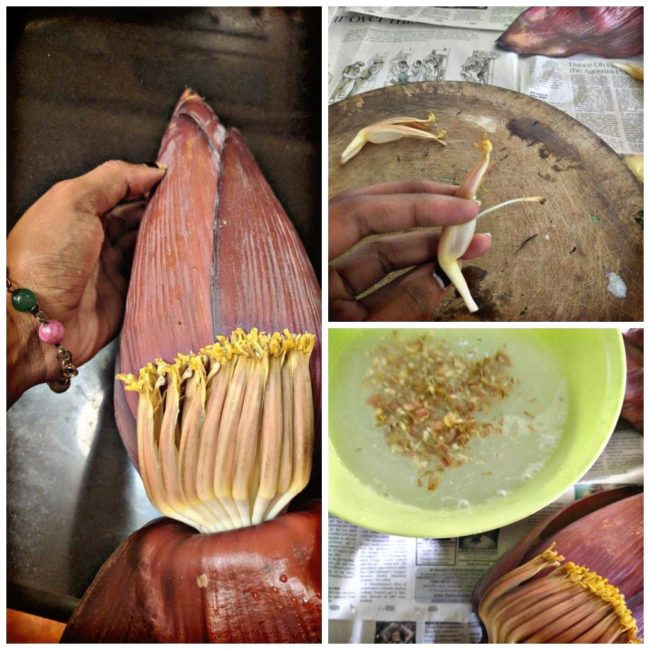
The stigma is a thick stem inside with a black rounded top which is not only difficult to chop but also lends a very bitter taste when cooked. Once removed, you can dice the banana flowers and let them soak in a bowl of water with a teaspoon of yogurt or buttermilk. This is to prevent the flowers from oxidising and becoming black. When it comes to the size as seen in the picture below, you can stop peeling the layers and just chop the whole bit.
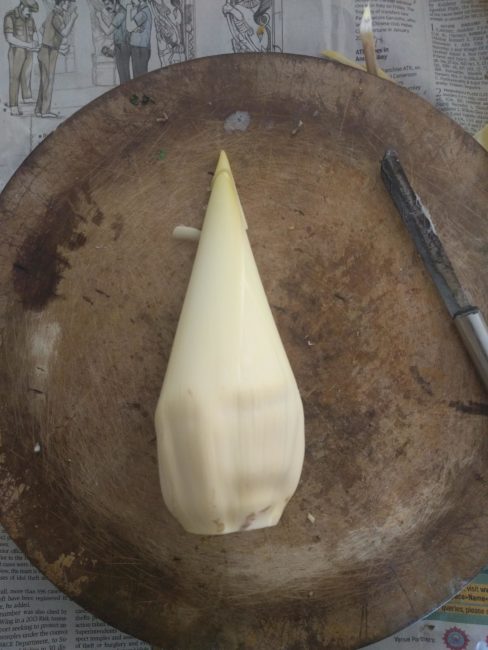
Once the lentils are done soaking, drain it out and grind half of it with some red chilies, fennel seeds, and asafoetida.
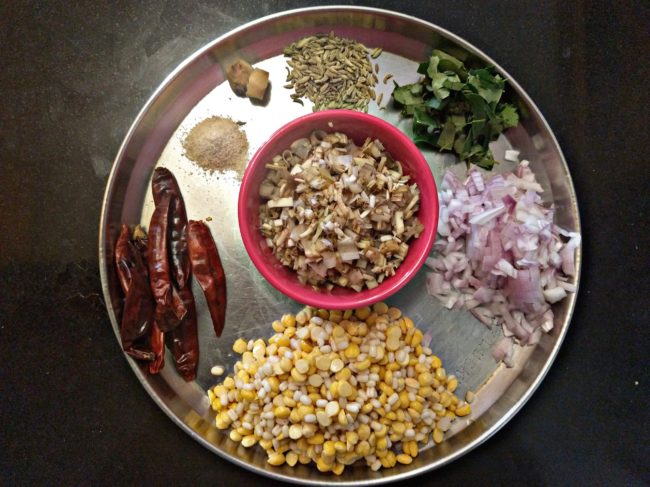
You can blend this well and keep it aside. Roughly blitz the other half of the lentils with the banana flowers and mix it with the remaining batter. To this, you can add salt, chopped onions, and curry leaves. We also experimented with adding drumstick leaves, which when fried brings a crunch. Make the batter into small balls (if its not sticking together, add a sprinkle of water,) flatten them slightly and fry them in hot oil. Drain carefully on a paper-lined plate and ta-da! Vazha Poo Vadai.
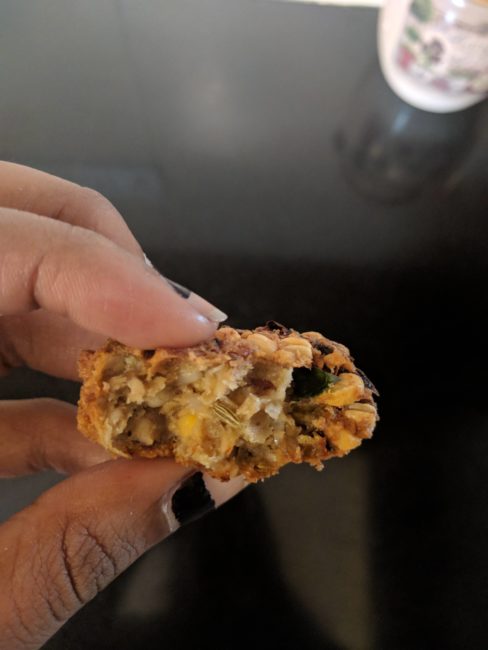
Enjoy them hot with a side of chutney.
A fun evening snack made of Bengal gram and banana flowers, perfect with a cup of chai.
Soak the Bengal gram and urud dal in water for three to four hours. Drain and set aside.
Peel and chop the banana flowers (I've given a much more detailed explanation on how to go about doing it in the piece above.) Make sure to soak them in a bowl of water and a tablespoon of yogurt/buttermilk to prevent from getting oxidized.
Blitz the fennel seeds, asafoetida, red chilies, and half of the soaked pulses. Set this aside.
In the second round, blitz the rest of the pulses and the banana flowers (without the buttermilk) for 2-3 seconds. It has to be rough.
Mix both batches of batter together along with the chopped onions, salt, and curry leaves. It should be a little sticky, but not too watery.
Bring the oil to heat. Wet your hands with water and divide the batter into small balls. When the oil is ready, one by one flatten the balls and gently place them into the oil. You can do batches of 5-10 depending on the size of your vessel. Don't over crowd it.
Fry them for 5-7 minutes on medium-high heat until they are golden brown. Drain them on a tissue and serve hot with a side of chutney.
Ingredients
Directions
Soak the Bengal gram and urud dal in water for three to four hours. Drain and set aside.
Peel and chop the banana flowers (I've given a much more detailed explanation on how to go about doing it in the piece above.) Make sure to soak them in a bowl of water and a tablespoon of yogurt/buttermilk to prevent from getting oxidized.
Blitz the fennel seeds, asafoetida, red chilies, and half of the soaked pulses. Set this aside.
In the second round, blitz the rest of the pulses and the banana flowers (without the buttermilk) for 2-3 seconds. It has to be rough.
Mix both batches of batter together along with the chopped onions, salt, and curry leaves. It should be a little sticky, but not too watery.
Bring the oil to heat. Wet your hands with water and divide the batter into small balls. When the oil is ready, one by one flatten the balls and gently place them into the oil. You can do batches of 5-10 depending on the size of your vessel. Don't over crowd it.
Fry them for 5-7 minutes on medium-high heat until they are golden brown. Drain them on a tissue and serve hot with a side of chutney.
